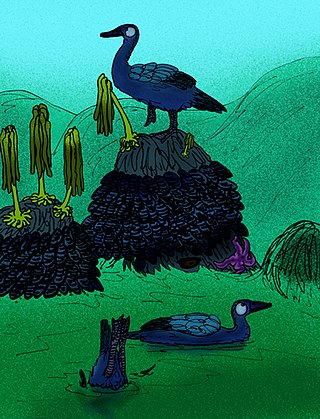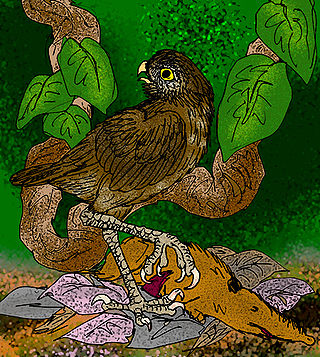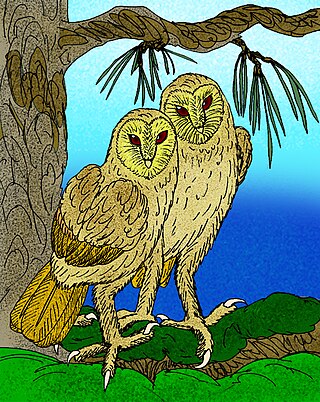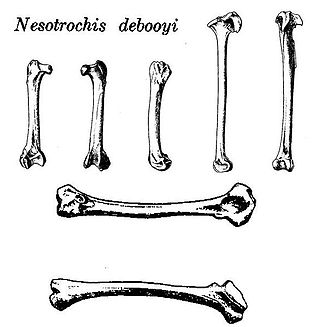
The Anatidae are the biological family of water birds that includes ducks, geese, and swans. The family has a cosmopolitan distribution, occurring on all the world's continents except Antarctica. These birds are adapted for swimming, floating on the water surface, and, in some cases, diving in at least shallow water. The family contains around 174 species in 43 genera.

Anseriformes is an order of birds also known as waterfowl that comprises about 180 living species of birds in three families: Anhimidae, Anseranatidae, and Anatidae, the largest family, which includes over 170 species of waterfowl, among them the ducks, geese, and swans. Most modern species in the order are highly adapted for an aquatic existence at the water surface. With the exception of screamers, males have penises, a trait that has been lost in the Neoaves, the clade consisting of all other modern birds except the galliformes and paleognaths. Due to their aquatic nature, most species are web-footed.

Anas is a genus of dabbling ducks. It includes the pintails, most teals, and the mallard and its close relatives. It formerly included additional species but following the publication of a molecular phylogenetic study in 2009 the genus was split into four separate genera. The genus now contains 31 living species. The name Anas is the Latin for "duck".

Flightless birds are birds that cannot fly. They have, through evolution, lost the ability to fly. There are over 60 extant species, including the well-known ratites and penguins. The smallest flightless bird is the Inaccessible Island rail. The largest flightless bird, which is also the largest living bird in general, is the common ostrich.

Frank Alexander Wetmore was an American ornithologist and avian paleontologist. He was the sixth Secretary of the Smithsonian Institution. He was also an elected member of both the American Philosophical Society and the United States National Academy of Sciences.

The steamer ducks are a genus (Tachyeres) of ducks in the family Anatidae. All of the four species occur at the southern cone of South America in Chile and Argentina, and all except the flying steamer duck are flightless; even this one species capable of flight rarely takes to the air. They can be aggressive and are capable of chasing off predators like petrels. Bloody battles of steamer ducks with each other over territory disputes are observed in nature. They even kill waterbirds that are several times their size.

Chendytes lawi is an extinct, goose-sized flightless marine duck, once common on the California coast, the California Channel Islands, and possibly southern Oregon. It lived in the Pleistocene and survived into the Holocene. It appears to have gone extinct at about 450–250 BCE. The youngest direct radiocarbon date from a Chendytes bone fragment dates to 770–400 BCE and was found in an archeological site in Ventura County. Its remains have been found in fossil deposits and in early coastal archeological sites. Archeological data from coastal California show a record of human exploitation of Chendytes lawi for at least 8,000 years. It was probably driven to extinction by hunting, animal predation, and loss of habitat. Chendytes bones have been identified in archaeological assemblages from 14 coastal sites, including two on San Miguel Island and 12 in mainland localities. Hundreds of Chendytes bones and egg shells found in Pleistocene deposits on San Miguel Island have been interpreted as evidence that some of these island fossil localities were nesting colonies, one of which Guthrie dated to about 12,000 14C years. There is nothing in the North American archaeological record indicating a span of exploitation for any megafaunal genus remotely as long as that of Chendytes.

The giant Cuban owl or giant cursorial owl (Ornimegalonyx) is an extinct genus of giant owl that measured 1.1 metres in height. It is closely related to the many species of living owls of the genus Strix. It was a flightless or nearly flightless bird and it is believed to be the largest owl that ever existed. It lived on the island of Cuba.

Tyto pollens is an extinct giant barn owl which lived in the Bahamas during the last Ice Age.

Cygnus falconeri is an extinct, very large swan known from Middle Pleistocene-aged deposits from Malta and Sicily. Its dimensions are described as exceeding those of the living mute swan by one-third, which would give a bill-to-tail length of about 190–210 cm (75–83 in). By comparison to the bones of living swans, it can be estimated that it weighed around 16 kg (35 lb) and had a wingspan of about 3 m (9.8 ft). Due to its size, it may have been flightless. The remains of the species are associated with the Elephas mnaidriensis faunal complex, and became extinct long before the arrival of people to Sicily and Malta. Its bones are exhibited at Għar Dalam museum in Birżebbuġa, Malta.

The Antillean cave rail, also known as DeBooy's rail, is an extinct species of flightless bird which occurred on Puerto Rico and the United States Virgin Islands.
Paleontology or palaeontology is the study of prehistoric life forms on Earth through the examination of plant and animal fossils. This includes the study of body fossils, tracks (ichnites), burrows, cast-off parts, fossilised feces (coprolites), palynomorphs and chemical residues. Because humans have encountered fossils for millennia, paleontology has a long history both before and after becoming formalized as a science. This article records significant discoveries and events related to paleontology that occurred or were published in the year 1976.
Paleontology or palaeontology is the study of prehistoric life forms on Earth through the examination of plant and animal fossils. This includes the study of body fossils, tracks (ichnites), burrows, cast-off parts, fossilised feces (coprolites), palynomorphs and chemical residues. Because humans have encountered fossils for millennia, paleontology has a long history both before and after becoming formalized as a science. This article records significant discoveries and events related to paleontology that occurred or were published in the year 1960.
Talpanas lippa, the Kauaʻi mole duck, is an extinct species of duck. It was first described by Andrew N. Iwaniuk, Storrs L. Olson, and Helen F. James in the journal Zootaxa in November 2009. It is the only known member of the genus Talpanas. It was endemic to the Hawaiian island of Kauai where the fossil remains were unearthed in the Makauwahi Cave, Maha‘ulepu. The archaeological association of the bones is about 6000 years BP.
Eonessa is an enigmatic genus of bird possibly belonging to bird order Gruiformes and which consists of the single species Eonessa anaticula.

Anas chathamica, the Chatham duck or Chatham Island duck is an extinct species of duck which once lived in New Zealand's Chatham Islands in the south-west Pacific Ocean. It likely became extinct in about the 16th century because of hunting by humans.
Shiriyanetta hasegawai is an extinct species of seaduck from the Pleistocene of Japan. It was flightless, similar to the also extinct Chendytes from the opposite side of the Pacific.











